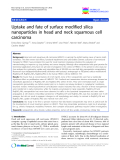
ISSN: 2615-9740
JOURNAL OF TECHNICAL EDUCATION SCIENCE
Ho Chi Minh City University of Technology and Education
Website: https://jte.edu.vn
Email: jte@hcmute.edu.vn
JTE, Volume 19, Special Issue 05, 2024
55
Fabrication of Hydrogel Beads Based on Mesoporous Silica
Nanoparticles/Chitosan and Application as a Slow-Release Fertilizer
My Chau Phan1, Hoang Thanh Han Tran1, Ngoc Nhu Y Ha1, Vu Hoang Giang Phan1, Van Quy
Nguyen2*
1Ton Duc Thang University, Vietnam
2Ho Chi Minh City University of Technology and Education, Vietnam
*Corresponding author. Email: quynv@hcmute.edu.vn
ARTICLE INFO
ABSTRACT
Received:
29/04/2024
Hydrogels have gained significant attention in various applications,
including agriculture, owing to their exclusive characteristics, such as great
water retention and controlled delivery of fertilizers and agrochemicals. In
this study, a nanocomposite hydrogel bead with exceptional slow-release
capacity for urea fertilizer has been fabricated by appropriately combining
urea, silica nanoparticles, and chitosan. The developed beads not only
enable the efficient delivery of nutrients to plants over a long period but
also enhance water retention capacity in sandy soil, resulting in minimally
negative impacts on the environment. The hydrogel beads were simply
prepared by dropping method. To effectively control the release of urea
from hydrogel beads, mesoporous silica nanoparticles (MSNs) with a
diameter of 56 nm were synthesized and used to load the urea (UM).
Subsequently, the UM hybrid was incorporated into the chitosan matrix to
form the hydrogel beads (UMCS). The resulting beads have a spherical
shape and high stability. They exhibited a sustained release of urea for over
a month and biodegradable capacity in soil. The hydrogel beads showed a
good swelling degree with a maximum value of 250% at pH 3. Moreover,
the hydrogel beads-embedded soil revealed a water retention capacity
significantly greater than the soil without the beads. These results
suggested that the nanocomposite hydrogel beads possess high application
potential in fertilizer delivery and smart agriculture.
Revised:
24/06/2024
Accepted:
27/08/2024
Published:
28/12/2024
KEYWORDS
Hydrogel;
Slow-release fertilizer;
Urea;
Chitosan;
Silica nanoparticles.
Doi: https://doi.org/10.54644/jte.2024.1578
Copyright © JTE. This is an open access article distributed under the terms and conditions of the Creative Commons Attribution-NonCommercial 4.0
International License which permits unrestricted use, distribution, and reproduction in any medium for non-commercial purposes, provided the original work is
properly cited.
1. Introduction
Fertilizers have played a crucial role in revolutionizing the agriculture sector, significantly increasing
crop yields and feeding the world’s burgeoning population. However, the efficient usage and
environmental impact of chemical fertilizers, especially on soil and groundwater, are growing concerns
[1]. The story of fertilizer used in agriculture is a complex issue between enhancing food production and
managing unintended environmental consequences. Excessive fertilizer use can alter the natural nutrient
balances, cause soil acidity, decrease microbial diversity, and damage soil structure. Moreover, the
heavy use of chemical fertilizers contributes to greenhouse gas emissions, including nitrous oxide, a
significant driver of climate change [2]. In particular, the efficacy of fertilizers is usually modest due to
the leaching to the environment, resulting in a high agricultural cost, negative effects on groundwater
quality, and environmental pollution [3], [4]. Recently, to address these environmental concerns and
increase the efficiency of agrochemicals, intelligent fertilizers that can offer a controlled release capacity
of fertilizers have been extensively studied and applied in practice [5], [6]. Slow-release fertilizers
powered by nanotechnology are essential for research orientation. The unique advantage of nano-
fertilizers lies in their ability to deliver nutrients directly to the cellular level of plants, enhancing nutrient
use efficiency and potentially reducing the environmental impact associated with traditional fertilization
methods. By encapsulating nutrients within nanoparticles, these fertilizers ensure a slow and more
controlled release of nutrients, which can be tailored to the needs of specific plants or crop stages,
optimizing growth and yield [7], [8].







